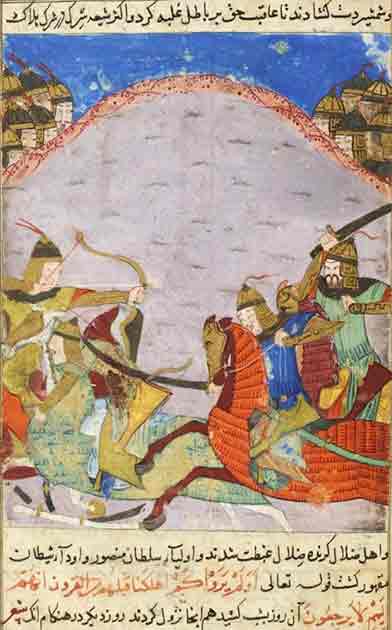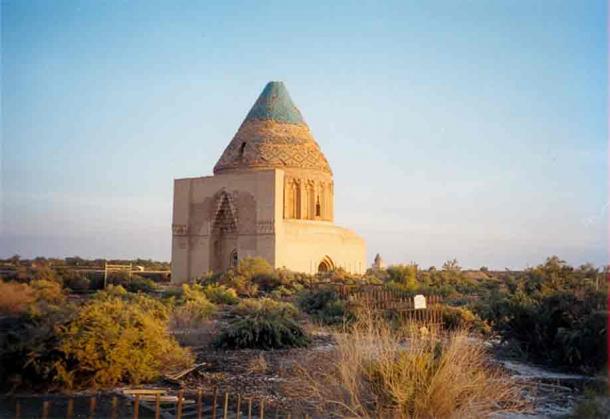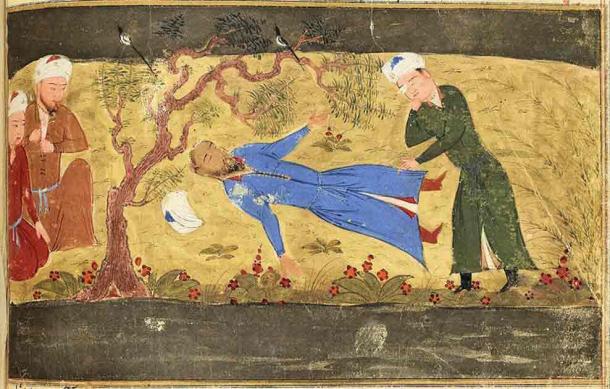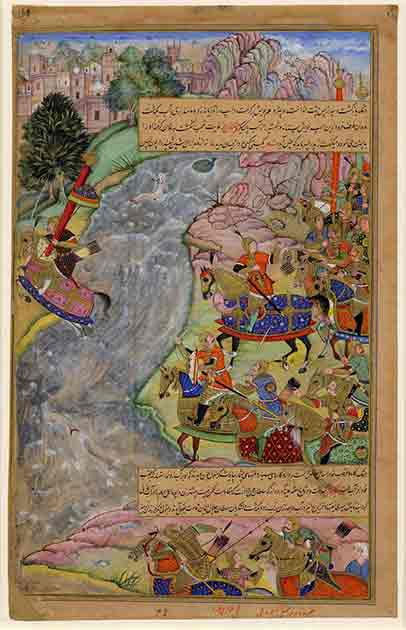
The Epic Rise and Demise of the Khwarazmian Empire
The Khwarazmian Empire, spanning from the 11th to the 13th centuries, flourished as a formidable power in Central Asia. Situated along the Silk Road, its strategic location fostered vibrant trade and cultural exchange. Governed by the Khwarazmian Dynasty, it rose to prominence under leaders like Ala al-Din Tekish and his successor, Muhammad II.
Renowned for its sophisticated administration and patronage of the arts and sciences, the Khwarazmian Empire witnessed remarkable advancements in mathematics, astronomy and architecture. Before its fall to the Mongols, it briefly stood as the greatest power in the Muslim world, its influence stretching far and wide.
The Ancient Origins of the Khwarazmian Empire
While the Khwarazmian Empire itself is generally believed to have begun in 1077 AD, its history actually stretches back much further. The Khwarazmian Empire was ruled by those bearing the title Khwarazmshah, which translates to “King of Khwarazm” or “Shah of Khwarazm.” In Persian, shah means “king” or “ruler,” while Khwarazm refers to the historical region in Central Asia where the Khwarazmian Empire was situated.
First used by the founder of the Afrigid Dynasty, this title actually dates back to 305 AD and was in continuous use until 995 AD. It fell out of use briefly, but it was being used again by 1017 when an uprising in Khwarazm saw the then Khwarazmshah and his wife killed at the hands of rebels. This led to the sultan of the Ghaznavid Empire, Mahmud, marching in and making Khwarazm a province of his Empire. It remained like this until 1034 AD.
- From Splendor to Ruin: The Epic Tale of the Abbasid Caliphate
- The Seljuks: Nomads Who Built an Empire and Took On Byzantine Power
Things were unsettled until 1077 when Anushtegin Gharchai, a Mamluk (slave mercenary) commander working for the Seljuks took control of Khwarazm and became its governor. He ruled over the region until his death in 1097. A new governor replaced him, Ekinchi ibn Qochqar, who quickly broke away from the Seljuks and announced himself as shah (leader/king) of the land.
Unfortunately for him, the Seljuks weren’t keen on this, and he was killed by several amirs (governors/princes) during a revolt. The Seljuks replaced the upstart with Qutb al-Din Muhammad, son of Anushtegin Gharchai, who went on to conquer much of the region and became the first hereditary Khwarazmshah.

The army of the Khwarazmian Empire during the Battle of Bolnisi in 1227. (Public domain)
Claiming Independence and Rising to Power: The Khwarazmian Empire's Ascendancy
Qutb al-Din Muhammad ruled from 1097 until he died in 1129 AD. Power then passed on to his son, Ala ad-Din Atsiz. He was arguably more ambitious than his father and spent his early reign securing Khwarazm’s border against nomad attacks and bolstering its forces.
In 1138 he made his move and led a rebellion against his Seljuk master, Sultan Ahmad Sanjar. The rebellion was short-lived and Atsiz was forced to flee his kingdom. In his place, the Sultan installed his nephew, Suleiman Shah, as Khwarazm’s new ruler.
Atzis, however, was not one to give up and soon returned home, determined to take back Khwarazm. He attacked the city of Bukhara but then, in 1141, decided diplomacy was a better idea. He knew the sultan’s nephew was struggling to control Khwarazm and submitted to Sultan Sanjar. Atzis was forgiven, pardoned, and given back control of Khwarazm.
His newfound loyalty to the Seljuk was just as short-lived as his original rebellion. The same year Atsiz was pardoned, the Seljuk suffered a devastating defeat at the Battle of Qatwan against the central Asian Kar Khitai power. Atsiz took this as an opportunity to invade the nearby Khorasan region, occupying Merv and Nishapur. Once again Atsiz’s ambitions got him in trouble. The Kara Khitai targeted Khwarazm next and forced Atsiz to start paying them tribute.
The following year, in 1142, Sultan Sanjar got his revenge and forced Atzis out of Khorasan. He then reinvaded Khwarazm and returned it to its vassal state status. Five years later Atzis tried to rebel against the Seljuks, but Sanjar put him down once again.
This doesn’t mean Atsiz’s rule was a failure, he was the first Khwarazmian ruler to claim independence (even if he did lose it again). He also managed to expand his kingdom and made many nomadic tribes reliant on the Khwarazmshah. By the time his life had drawn to a close he had taken control over most of northwest Central Asia and Khwarazm was mostly independent, although it was forced to continue paying tribute to the Kara Khitai and Seljuk.

Khwarazmshah Il-Arslan at his coronation, as depicted within the 14th-century book Jami’ al-Tawarikh. Khwarazmshah Il-Arslan played a significan role in the expansion of the Khwarazmian Empire. (Public domain)
Rapid Expansion of the Khwarazmian Empire
Following Atsiz’s death in 1156 his son, Il-Arslan, became Khwarazmshah. Il-Arslan shared his father’s expansionist ideals but started his reign by playing things smart. He did this by initially avoiding conflict with both the Seljuks and Kara Khitai and continuing to pay tribute to both.
This approach paid off when just a few months into Arslan’s reign the Seljuk leader, Sanjar, died. The Seljuk-held lands fell into chaos, giving Arslan the chance to claim independence while remaining on friendly terms with Sanjar’s replacement, Mas’ud. He then followed in his father’s footsteps and sneakily began expanding into Khurasan while outwardly remaining peaceful with the Seljuks.
Two years into his reign Arslan began trying to step out of his father’s shadow. The Karluks, a confederacy of nomadic tribes, were being persecuted by the Karakhanids of Samarqand. Several of their leaders fled to Khwarazm to ask for Arslan’s help. Despite the fact that Karakhanid was a vassal state of his allies, the Qara Khitai, Arslan agreed and invaded.
It was a risky move but a major success for Arslan. The Khwaramian army, which consisted mainly of heavily armored cavalry known as cataphracts and highly skilled light cavalry units like horse arches, proved to be more than a match for the Karakhanids. They easily beat them, forcing the enemy to beg for help from the Qara Khitai, who sent an army to help out their vassal state.
Upon arriving, however, the Qara Khitai commander took one look and changed his mind. Arslan had proven the Khwarazmians were a force to be reckoned with and the commander decided it would be a bad idea to attack. Arslan’s gamble had paid off, he had concreted his fledgling empire’s status as a major player in the region.
This isn’t to say that Qara Khitai chose to forgive and forget. The relationship between the Khwarazmian Empire and Qara Khitai continued to devolve and in 1172 the Qara Khitai attacked the Khwarazmians. Over the years Arslan had slowly stopped paying tribute to the Qara Khitai and so it was deemed enough was enough- the once subordinate Khwarazmian ruler needed to be put in his place.
This time things didn’t go so well for Arslan. The Qara Khitai’s superior forces beat the Khwarazmian army without too much trouble. During the fighting, Arslan fell ill and died shortly after. There was then a brief succession crisis as both of Arslan’s sons, Tekish and Sultan Shah, fought over the throne. Tekish came out on top and came to power the same year his father died.
Tekish, who ruled from 1172 to 1200, was a wily leader, adept at both making alliances and breaking them. He gained the throne by swearing fealty to the Qara Khitai and accepting their suzerainty (partial control). Then, not long after becoming Khwarazmshah he promptly stabbed them in the back and declared Khwarazm’s independence.
The Qara Khitai attempted a retaliatory invasion, but it failed. Tekish then turned his attention to expanding his empire’s lands, in particular into Iran. He largely did so by allying himself with the region’s Oghus Turkmens and Qipchak Tribes who were known for being particularly fierce warriors. The Khwarazmian army’s weak spot had always been its poorly trained and equipped militias and recruiting these tribes seriously bolstered Tekish’s forces.
In 1194 Tekish made another important alliance, this time with his neighbor, Caliph Al-Nasir of Baghdad’s Abbasid caliphate. The two powers teamed up and attacked the Seljuk caliph of Hamaan, Toghrul III. With their combined might they easily defeated Toghrul’s forces and conquered his lands.
Tekish then split from his new ally, nearly sparking another war in the process. Rather than go to war with the increasingly powerful Khwarazmians the Abbasid caliph accepted Tekish as the ruler of Iran, Khorasan and Turkestan.
Tekish had done more than any of his predecessors to expand the Khwarazmian Empire’s borders. The empire had also become unbelievably prosperous under his rule with its capital Urganch/ Gurganj becoming famous for both its wealth and beauty. One of the Khwarazmian Empire’s greatest rulers died in 1200 AD, killed by an infected abscess behind his tonsils. His death sparked massive revolts across Khwarazmian-held lands, especially in Iran where Khwarazmian soldiers were massacred by the locals.

The mausoleum of Ala al-Din Tekish, the Shah of the Khwarazmian Empire from 1172 to 1200, stands majestically in Kunya-Urgench, Turkmenistan. This city was once a vibrant hub during the Khwarazmian era. (Doron / CC BY-SA 3.0)
How Pride Destroyed the Khwarazmian Empire
Most empires peak for a while and then slowly begin to decline. This wasn’t the case for the Khwarazmian Empire which peaked and then almost immediately entered a death spiral. Also unusual, the empire’s peak and decline were thanks to one man, Arslan’s son and successor, Muhammad II.
Muhammad got off to a strong start. He quickly put down the revolts sparked by his father’s death and began expanding his empire at an unprecedented rate. He destroyed the Western Kara-Khanid Khanate in 1213 and then defeated the Ghurids in 1215, assassinated their leader and vassalized them. In a few short years, the Khwarazmian Empire had become bigger than it had ever been before.
Unfortunately, in 1218 Muhammad started making spectacularly bad decisions. That year a group of Mongols briefly crossed into Khwarazmian lands while chasing an enemy general. While the Mongols had no ill intentions towards Khwarazm, Muhammad misread the situation. Following this accidental incursion the Mongol leader, the infamous Genghis Khan, contacted Muhammad hoping to smooth things over and open up trade relations.
Instead, Muhammad instructed his uncle and governor, Inalchuq, to accuse Genghis Khan’s emissaries of spying. Their goods were seized and the men were arrested. Muhammad knew Genghis Khan’s reputation and had mistaken an olive branch as a ploy to invade Khwarazm.
It seems Genghis Khan genuinely wanted to be friends though, as he sent three envoys to Muhammad, giving him the chance to play dumb and return the first party. Muhammad had the new envoys executed and then made things even worse by putting the original party to death. He had picked a fight with one of the most feared men in history.
This was the final straw for Genghis Khan who finally gave up and retaliated in 1219. He sent a force of 100,000 to 150,000 men to attack the Khwarazmian Empire’s richest cities. The cities were plundered, and their citizens slaughtered by the Mongol horde in one of history’s bloodiest wars.
Following the fall of his empire’s capital Muhammad realized there was no going back and fled. He died in 1120 from pleurisy, a lung inflammation. In less than two years the Mongols had conquered all of the Khwarazmian Empire.

The death of Muhammad II, as depicted on a 1430 manuscript. His rule was defined both by expansion and conflict for the Khwarazmian Empire. (Public domain)
Last Hurrah of the Khwarazmian Empire
Perhaps we shouldn’t be too hard on Muhammad II. During his reign, his mother, Turkan Khatun, held an unusual level of power. Not only did she hold the title Khudavand-e Jahaan (ruler of the world), but she had her own Diwan (government office) and palace. She held so much sway that all of Muhammad’s orders had to be signed off by her before being enacted. It’s thought the two didn’t get along and both constantly vied for control, leading to governing instability that the Mongols ruthlessly exploited.
This instability continued following Muhammad’s death in 1220. His eldest son, Jalal ad-Din Mingburnu, became Khwarazmshah but had his grandmother to contend with. Jalal already had some experience ruling—his father had given him the southwest to rule over in 1215—but this didn’t stop her from trying to overthrow him.
- How Successful Was the Mongol Empire? (Video)
- Genghis Khan: What Transformed Temujin Borjigin into an Unstoppable Force Bent on World Domination?
Turkan Khatun seems to have had a problem with the fact that Jalal’s mother had been a low-born concubine. Instead, she backed Jalal’s half-brother, Uzlagh-Shah, whose mother was highborn and hailed from the same tribe as Turkan. Thankfully for Jalal his grandmother was kidnapped by Genghis Khan’s troops in 1221 and never returned, dying in poverty in Mongolia.
Even after his grandmother’s disappearance, Jalal decided not to stick around. He initially tried to flee to India, but the Mongols quickly caught up with him, defeating Jalal at the Battle of Indus. He then pleaded for asylum in the Sultanate of Delhi but was denied. Jalal had powerful enemies (like the Abbasid Dynasty) and the Sultanate wasn’t looking to upset them.

Painting depicting the last Shah of the Khwarazmian Empire, Jalal al-Din Mangburni, crosses the Indus River to escape the forces of Genghis Khan at the Battle of the Indus. (Public domain)
Following this failure, Jalal had little choice but to return to Persia. He attempted to re-establish the kingdom of Khwarazm, but spent most of his rule fighting off the Mongols, Seljuks and threats from his own family. Things got off to a bad start when he lost Persia after being defeated by the Mongols in the Alborn mountains. Following this he was forced to flee to the Caucasus, a region between the Black Sea and Caspian Sea.
In 1225 he captured Azerbaijan and founded his new capital in Tabriz. The following year, feeling emboldened, he attacked Georgia and managed to sack Tbilisi. He then attacked the powerful Ayyubid Dynasty and captured the town of Ahlat. Was the Khwarazmian Empire seeing a resurgence?
Not really. This last attack caught the attention of the Seljuks of Rum, who promptly attacked and defeated Jalal at the Battle of Yassicemen in 1230. Jalal managed to escape once again but the Mongols took this as a chance to take most of the land he’d spent the last few years trying to conquer. He made his way to Diyarbakir, a city in modern-day Turkey, but was murdered in 1231 by Kurdish highwaymen. The last Khwarazmshah was dead and with him died what little was left of the Khwarazmian Empire.
The rise and fall of the Khwarazmian Empire encapsulate a chapter of grandeur and tragedy in Central Asian history. From its zenith as the preeminent power in the Muslim world, fostering trade and cultural exchange along the Silk Road, to its devastating demise at the hands of the Mongol onslaught, the empire left an undeniable mark on the region.
Today the Khwarazmian Empire is most often remembered for its stunning defeat at the hands of the Mongols, but that legacy is undeserved. Founded by a slave, the Khwarazmian Empire rose up from humble beginnings to become a powerhouse of the Muslim world. Its story highlights the ebbs and flows of power throughout history, reminding us of the fleeting nature of empires.
Top image: Representative image of warriors of the Khwarazmian Empire, from a 13th-century Mina’i bowl. Source: Public domain
References
Brinkhol. T. 4 April 2023. “The insult that sparked Genghis Khan to destroy an empire” in Big Think. Available at: https://bigthink.com/the-past/genghis-khan-insult/
Farrokh. K. 2012. “The Mongol Invasion of the Khwarazmian Empire: The Fierce Resistance of Jalal-e Din” in Medieval Warfare Vol. 2, No. 3, pp. 43-49. Available at: https://www.jstor.org/stable/48578023
Zafar. W. 16 March 2023. “The Mongol invasion of the Khwarazmian Empire” in Medium. Available at: https://medium.com/@waheed.syed912/the-mongol-invasion-of-the-khwarazmian-empire-271d022f66ae















